Input interpretation

perchloric acid
Chemical names and formulas
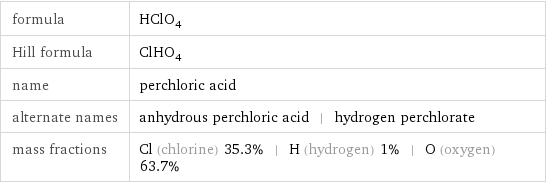
formula | HClO_4 Hill formula | ClHO_4 name | perchloric acid alternate names | anhydrous perchloric acid | hydrogen perchlorate mass fractions | Cl (chlorine) 35.3% | H (hydrogen) 1% | O (oxygen) 63.7%
Lewis structure
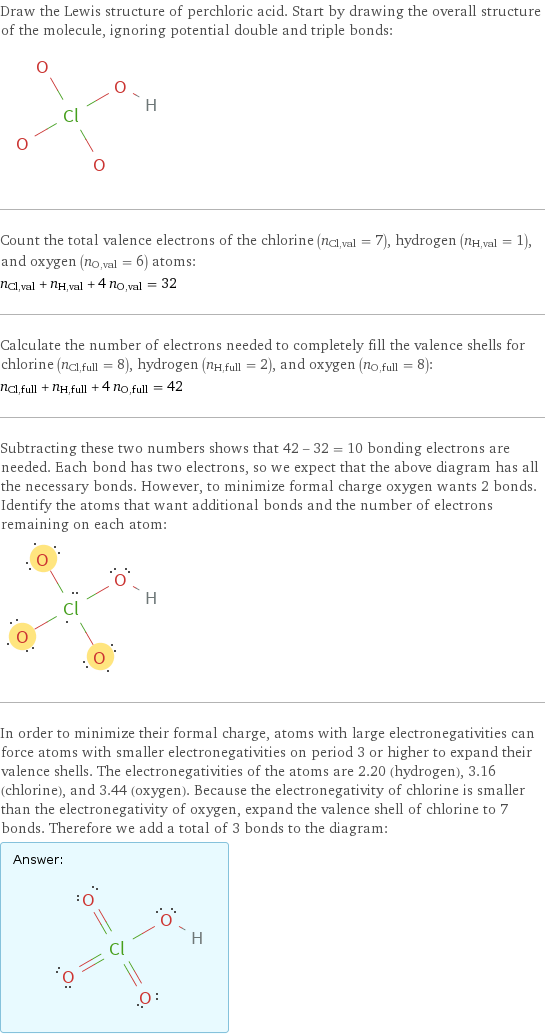
Draw the Lewis structure of perchloric acid. Start by drawing the overall structure of the molecule, ignoring potential double and triple bonds: Count the total valence electrons of the chlorine (n_Cl, val = 7), hydrogen (n_H, val = 1), and oxygen (n_O, val = 6) atoms: n_Cl, val + n_H, val + 4 n_O, val = 32 Calculate the number of electrons needed to completely fill the valence shells for chlorine (n_Cl, full = 8), hydrogen (n_H, full = 2), and oxygen (n_O, full = 8): n_Cl, full + n_H, full + 4 n_O, full = 42 Subtracting these two numbers shows that 42 - 32 = 10 bonding electrons are needed. Each bond has two electrons, so we expect that the above diagram has all the necessary bonds. However, to minimize formal charge oxygen wants 2 bonds. Identify the atoms that want additional bonds and the number of electrons remaining on each atom: In order to minimize their formal charge, atoms with large electronegativities can force atoms with smaller electronegativities on period 3 or higher to expand their valence shells. The electronegativities of the atoms are 2.20 (hydrogen), 3.16 (chlorine), and 3.44 (oxygen). Because the electronegativity of chlorine is smaller than the electronegativity of oxygen, expand the valence shell of chlorine to 7 bonds. Therefore we add a total of 3 bonds to the diagram: Answer: | |
Basic properties
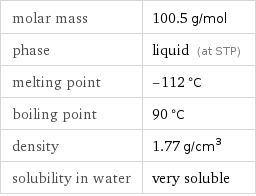
molar mass | 100.5 g/mol phase | liquid (at STP) melting point | -112 °C boiling point | 90 °C density | 1.77 g/cm^3 solubility in water | very soluble
Units

Liquid properties (at STP)
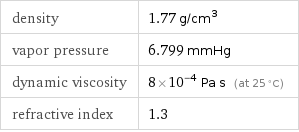
density | 1.77 g/cm^3 vapor pressure | 6.799 mmHg dynamic viscosity | 8×10^-4 Pa s (at 25 °C) refractive index | 1.3
Units

Thermodynamic properties

molar heat of vaporization | 30.3 kJ/mol specific heat of vaporization | 0.302 kJ/g molar heat of fusion | 6.9 kJ/mol specific heat of fusion | 0.06869 kJ/g (at STP)
Chemical identifiers
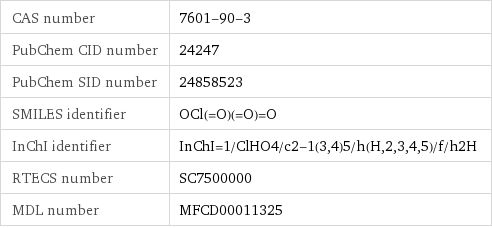
CAS number | 7601-90-3 PubChem CID number | 24247 PubChem SID number | 24858523 SMILES identifier | OCl(=O)(=O)=O InChI identifier | InChI=1/ClHO4/c2-1(3, 4)5/h(H, 2, 3, 4, 5)/f/h2H RTECS number | SC7500000 MDL number | MFCD00011325
NFPA label

NFPA label
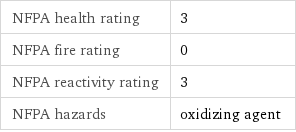
NFPA health rating | 3 NFPA fire rating | 0 NFPA reactivity rating | 3 NFPA hazards | oxidizing agent
Toxicity properties

odor | odorless

RTECS classes | other
Ion equivalents

H^+ (hydrogen cation) | 1 (ClO_4)^- (perchlorate anion) | 1